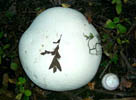(pl. Lichens)
Terms discussed: mycobiont (pl. mycobionts), photobiont (pl. photobionts), phycobiont (pl. phycobionts), xenobiont (pl. xenobionts)
See Also:
Fungal Lifestyle
propagule
A lichen is a symbiotic organism, composed of a fungus and an algae (sometimes also a cyanobacterium) living together in a single composite body, known as a thallus. In general, the fungal symbiont provides structure and anchorage for the thallus, while the other bionts busy themselves with photosynthesizing food. The official definition of a lichen (approved by the International Association of Lichenology) is "A lichen is an association of a fungus and a photosynthetic symbiont resulting in a stable thallus of specific structure."
Back to top
It consists of a fungal “partner”, or mycobiont, and one or more photosynthetic partners or photobionts, which can be either green algae or cyanobacteria. The photobiont(s) used to be called the phycobiont; but as that refers specifically to algae, leaving the cyanobacteria out in the cold, it is no longer considered appropriate. Also, I must say that it was only recently that everyone accepted that cyanobacteria are more closely related to bacteria than to algae, so the terminology change was held up for that reason also. Researchers are also starting to realize that lichens are complete little ecosystems, not just a partnership between two or three organisms. A lichen in the wild also houses many xenobionts, organisms that are not part of the "primary" symbiosis. These xenobionts are usually bacteria or fungi. Their role is lichen ecology and physiology is virtually unknown. But then, the same can be said for most aspects of lichen biology.
Back to top
Lichens are amazingly different from all other organisms. They have incredibly slow metabolisms and growth rates. While this makes them very vulnerable, in the short run, to organisms such as lichen collectors, which have eradicated several species of lichen in Great Britain. It also means that, if left alone, they live for hundreds or thousands of years (they are comparable, in this respect, to the more famous bristlecone pines). We really know next to nothing about how the lichen symbiosis works. This is partly because (and partly a cause of) it is almost impossible to grow lichens artificially - - most of the time, the lichen partners, brought together in the "unromantic" atmosphere of the botany lab, fail to establish a mutual attraction. Even when the partners do establish a symbiosis (formation of a thallus is usually taken to be evidence of this), it is usually clearly different (again, as shown by the thallus formation) from that formed by the same partners in the wild. (The current wisdom is that in the wild, the interaction is moderated by xenobionts not present in the artificial situation). And even when the symbiosis is established, they still grown verrrrry slowly. So, as a result of the difficulty in culturing them, we know very little about their biology; and, likewise, because we know so little about their biology, we still find them very difficult to grow. And so on, and so on.
Back to top
Lichens synthesize a variety of unique compounds, many of which are unique not only to the lichen, but to the symbiosis (that is, neither partner will create the compound on their own). And as part of cryptogamic crusts, they held down the soil in a way that made the first colonization of land by vascular plants possible, and still hold down much of the soil in our Southwestern deserts and in the long semi-desert strip of land just to the East of the Rockies, keeping this part of our continent from looking like the Sahara.
Back to top
Lichens are fascinating organisms, and I look forward to presenting more information about them in the future generations of this web site.











